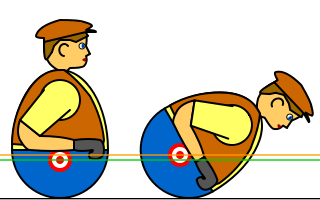Roly-poly toy

A roly-poly toy, round-bottomed doll, tilting doll, tumbler or wobbly man is a toy that rights itself when pushed over. The bottom of a roly-poly toy is round, roughly a hemisphere. Many roly-poly toys are hollow, with a weight inside the bottom. They have a center of mass below the center of the hemisphere, so that any tilting raises the center of mass. When such a toy is pushed over, it wobbles for a few moments while it seeks the upright orientation, which has an equilibrium at the minimum gravitational potential energy.
The toy can represent a person, an animal, or anything else. Different toy manufacturers and different cultures produce different-looking roly-poly toys: the okiagari-koboshi and some types of Daruma doll of Japan, the nevаlashka or vanka-vstanka of Russia, and Playskool's Weebles. Japanese okiagari means "to get up (oki) and arise (agari)"; the self-righting characteristic of the toy has come to symbolize the ability to have success, overcome adversity, and recover from misfortune.[1]
Traditional Chinese examples are hollow clay figures of plump children, but "many Chinese folk artists shape their tumblers in the image of clownish mandarins as they appear on stage; in this way they mock the inefficiency and ineptitude of the bureaucrats".[2]
A toy manufacturer recommends roly-poly toys for small children just developing motor skills; a child can bat at it without it rolling away.[3]
Dynamogene Theater stages a performance called "Monsieur Culbuto", allowing the audience to interact with a human dressed as a roly-poly toy.
The Noddy stories by Enid Blyton have characters Mr. and Mrs Wobblyman, who are based on this sort of roly-poly toy. One of the puppets/non-human presenters in the TV show Playbus (later Playdays) was a roly-poly clown called Wobble.


See also
References
| Wikimedia Commons has media related to Roly-poly. |
- ↑ Kyburz, Josef A., "'Omocha': Things to Play (or Not to Play) With" Asian Folklore Studies, Vol. 53, No. 1 (1994), p. 15.
- ↑ Lang Shaojun, "Traditional Chinese Painting in the Twentieth Century", Three Thousand Years of Chinese Painting (New Haven: Yale UP, 1997), p. 312. ISBN 0-300-07013-6
- ↑ Fisher-Price - All About Play ... stages, toys & tips: Roly-poly bat-at toys